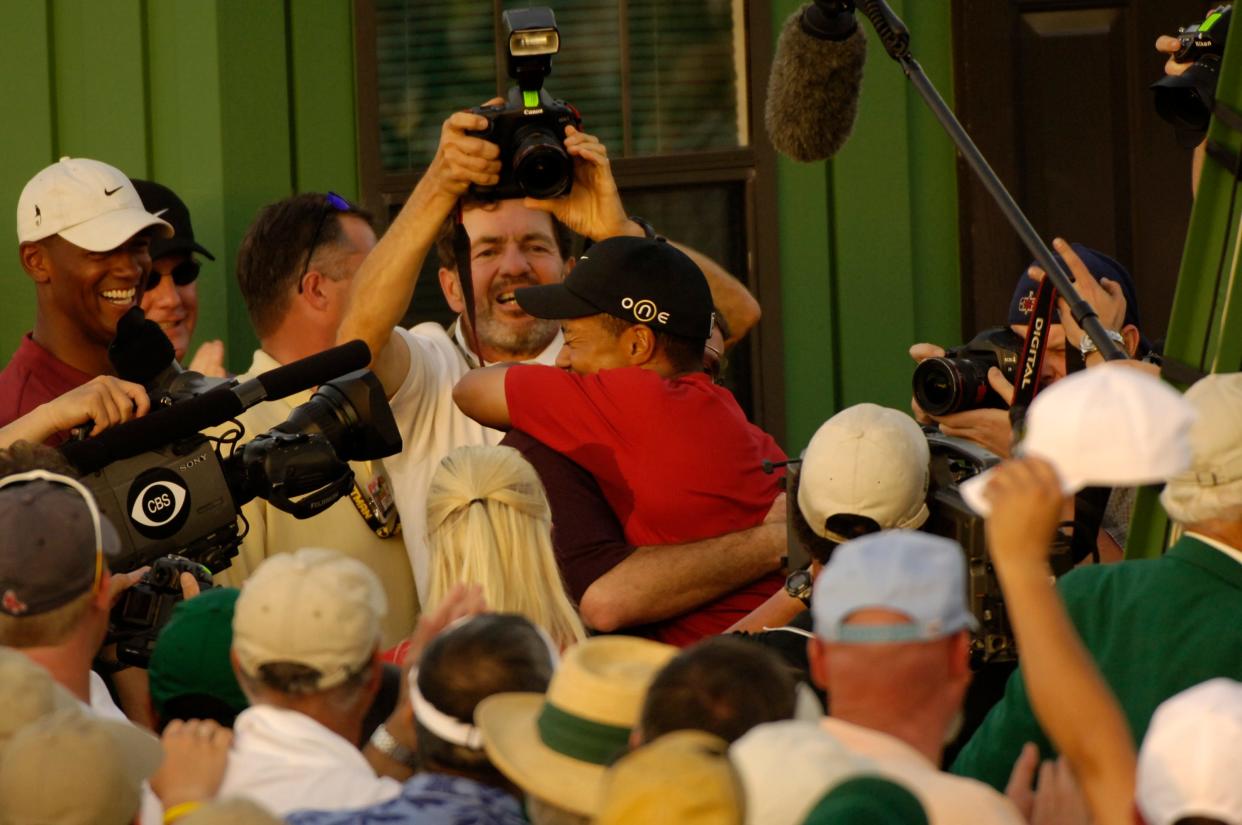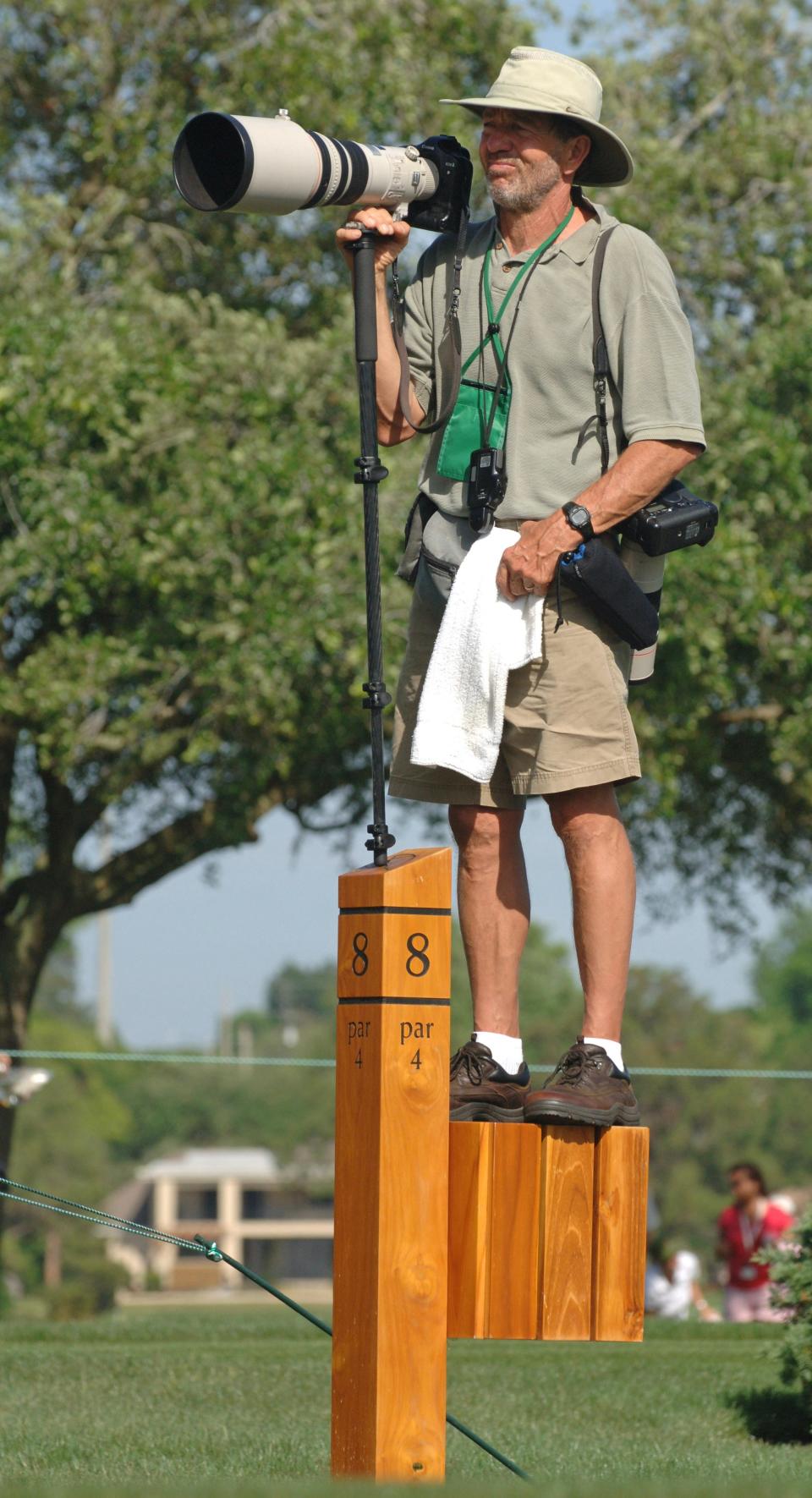Tiger Woods, Port St. Lucie photographer share office, goal of pulling off the perfect shot

- Oops!Something went wrong.Please try again later.
When they shared the same office, Tiger Woods and golf photographer Stephen Szurlej had similar goals: to pull off the perfect shot.
Woods was trying to make history and Szurlej hoping to record it. But they had only one chance at their elusive goals: There are no mulligans in professional golf, after all.
While Woods’ heroics brought thunderous ovations, Szurlej couldn’t make a peep. Not a sound from either he or the cameras strapped to his body.
“The worst thing you could do,” Szurlej said, “is interrupt a golfer on the course.”
LIV golfers not welcome:Seminole Golf Club to LIV Golfers: You're not welcome
Trump wins own championship:Trump declares himself the winner of his own club championship - in the Trumpiest way ever
LIV 2023 schedule:LIV Golf adds second event in Florida; moves tournament at Doral up one week
Szurlej remembers a World Golf Championship event at Firestone when he found a great angle to shoot Woods’ next shot. But Szurlej was in Woods’ line of sight, so as he lay in the deep grass, he could not move a muscle or make a noise — or expect to get a mouthful from Woods and caddie Steve Williams
“I could have sworn Tiger had no idea I was there,” Szurlej said. “His divot landed squarely on my face. As he walked past me, he said, ‘That was pretty good, wasn’t it?’”

The 73-year-old Szurlej was pretty good at what he did, too. The PGA of America recently announced that the Port St. Lucie resident would become the third recipient of the Lifetime Achievement Award in Photojournalism after a career that included more than 100 majors, more than 400 PGA Tour events and trips to 15 countries.
Szurlej, who spent most of his three-decade career working at Golf Digest/Golf World, will be honored at the PGA Championship at Oak Hill in Rochester, N.Y., in mid-May. If it was up to him, he’d have the ceremony tonight.
“I’ve never been one to seek the spotlight, so I’m not real comfortable with this,” Szurlej said. “But this award means a lot to me. I was pretty surprised when I got the call. It wasn’t on my radar.”
Golf photographers walk 10 miles carrying 15 pounds of equipment
Being a golf photographer is a tough job. Physically, you have to be able to walk about 10 miles a day, usually in sultry, hilly conditions, carrying around about 15 pounds of equipment.
Moreover, a golf course is obviously not like other sports arenas, which are more confined, with the photographers usually sitting next to each other. A golf course can be spread over 20 acres, with more than 70 players on the course at the same time, with everything seeming to happen at once and the lighting changing by the second.
Somehow, Szurlej thrived in these chaotic moments.
“Stephen Szurlej’s extraordinary ability to capture golf’s most memorable moments, athletes and courses through imagery has made an everlasting impact on our game,” said PGA of America President John Lindert. “Stephen set the standard for golf photography through his masterful artistic ability and relentless work ethic.”
Szurlej didn’t plan on becoming a photographer while growing up in New Jersey. He thought he might become an accountant or an FBI agent. But when he was a freshman at Bowling Green, his roommate said he was going to a sports photography class.
That intrigued Szurlej, who went to the class, picked up a camera and never put it down. He spent five years at a weekly newspaper in Danbury, Connecticut, which not only was one of the few U.S. papers that ran color photos at the time but provided him access to big-time sports events in nearby New York.
Golf Digest hired Szurlej in 1980, and he spent the next 15 years shooting golf and tennis for a sister publication. Eventually, he concentrated on the sport with the small white ball.
His career prospered through a work ethic that would have him arrive at major championship venues a year before to scout for the best locations at certain times of the day. He was meticulous.
“Stephen really had talent, but he also worked very hard,” said fellow photographer Dom Furore, who worked with Szurlej at Golf Digest for 25 years. “There’s a lot of strategy in shooting golf that most people don’t realize. He just had a knack of knowing when a player was going to sink a putt and which way he would turn afterward.
“And when Stephen started shooting golf, autofocus was a relatively new thing. He was using film, and the margin of error on exposure was almost zero. It had to be perfect to have focus.”
Szurlej pointed out another big change: “The cameras made noises when you clicked. Now they’re silent.”
Picking his most-memorable photo is not easy, but one image that stood out for Szurlej was when Woods was in contention to win the 2005 Masters. Woods’ approach at the par-3 16th landed left of the green, leaving him with an awkward shot.
Szurlej knew from his years of covering the Masters the line Woods would have to take with his chip to have a chance at holing it. But unlike the other major championships and PGA Tour events, photographers are not allowed inside their hallowed yellow ropes at Augusta National (there are several platforms).
He stood behind the packed gallery and made the risky choice of lifting his camera and shooting over the patrons’ heads, knowing there might be a fan’s arm in the way or he might lose focus.
Woods’ chip hung on the edge of the cup for an agonizing few seconds before falling in and the place went crazy.
“Arms flew up in front of me as I struggled to thread the needle and keep my focus point on Tiger,” Szurlej said. “I chose the correct position but was lucky an outstretched arm was not in my direct line of sight at the time of Tiger’s peak expression. I had several frames ruined by raised arms but only needed one.”
Tiger is his favorite golfer to shoot but ...
When asked if he had a favorite player to shoot, Szurlej’s answer was obvious: the guy who put the divot on his face.
“Tiger was the best because he was so reactive,” Szurlej said. “We wish he could give classes to other players on how to react after a big moment.
“But Tiger also made our job difficult because he broadened the horizons. Everyone wanted a piece of Tiger. He brought out a lot of non-golf photographers who weren’t aware of the rules we followed on the golf course.”
Szurlez also shot frame-by-frame instructional photos for Golf Digest — allowing him to build relationships with the top players — and shot visuals of famous courses later in his career. But he missed the excitement the final round of a major brings.
“It’s fun to capture that one image that records history,” he said.
His decision to spend winters in Port St. Lucie about 15 years ago happened naturally. He found himself making a dozen trips to South Florida during the winter to shoot players, instructors and private clubs, so why not spend the winters here?
“Plus the ocean is nearby,” said Szurlej, an avid surfer who still looks like he could run a marathon.
The PGA of America created the Lifetime Achievement Award in Photojournalism in 2020. The inaugural winner was Leonard Kamsler, one of Szurlej’s closest friends. David Cannon won in 2022.
“There there are a lot of great golf and sports photographers out there, so I’m thrilled to win,” Szurlej said. “Getting the best picture, a winning moment, is really a lot of hard work, a lot of effort and sometimes some luck, too.”
This article originally appeared on Palm Beach Post: Tiger Woods, Port St. Lucie photographer share goal of perfect shot

